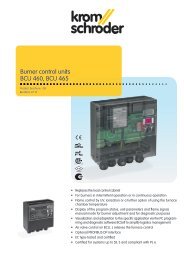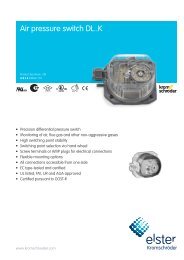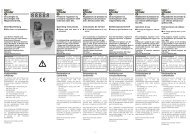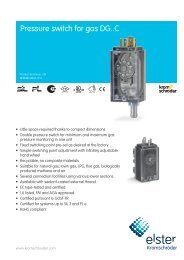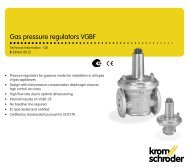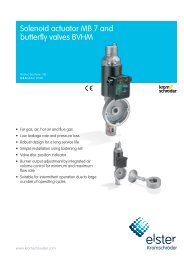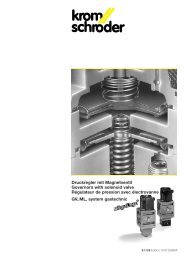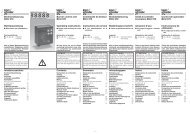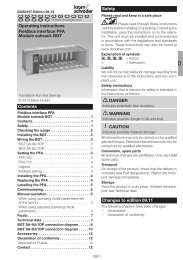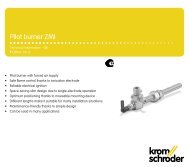IFS 110IM, IFS 111IM - Docuthek - Kromschroeder
IFS 110IM, IFS 111IM - Docuthek - Kromschroeder
IFS 110IM, IFS 111IM - Docuthek - Kromschroeder
- No tags were found...
You also want an ePaper? Increase the reach of your titles
YUMPU automatically turns print PDFs into web optimized ePapers that Google loves.
Verdrahten Anlage spannungsfrei schalten. Zur Verdrahtung vorbereitete Durchbrüchebenutzen. Ionisationsüberwachung:<strong>IFS</strong> <strong>110IM</strong> in geerdeten Netzeneinsetzen.<strong>IFS</strong> <strong>111IM</strong> kann in erdfreien Netzeneingesetzt werden. Erfordert dannzusätzlichen Trenntransformator. PG 9 Verschraubung für Leitungsdurchmesser4 – 8 mm einsetzen. Gasfeuerungsautomat verdrahtennach Anschlussplan. Gute Schutzleiterverbindung amGasfeuerungsautomaten und amBrenner herstellen, sonst kann dasGerät beim Einelektrodenbetriebzerstört werden. Bei Betrieb ohne FlammenwächterKlemme 7 und 11 brücken.ACHTUNG! Ausgänge nicht rückwärts mitSpannung beschalten. Anschluss nur mit fester Verdrahtung. L1 und N nicht vertauschen. Resetfunktion nicht zyklischautomatisch ansteuern.Wiring Disconnect the system from theelectrical power supply. Use the prepared holes for wiring. Ionisation control:<strong>IFS</strong> <strong>110IM</strong> is to be used ingrounded mains.<strong>IFS</strong> <strong>111IM</strong> may be used in ungroundedmains, which requires anadditional isolating transformer. Use PG 9 cable gland for cablediameters of 4 to 8 mm. Wire the automatic burner controlunit as shown in the connectiondiagram. Make a good PE (ground) wireconnection from the automaticburner control unit and to theburner, otherwise the appliancemay be damaged when used ona single-electrode operation. For operation without flame detectorsbridge terminals 7 and 11.CAUTION! Ensure that voltage outputs andinputs are the same polarity andare not reversed. Connection only with permanentwiring. Do not reverse L1 and N. Do not set the reset function sothat it operates automatically incycles.Câblage Mettre l’installation hors tension. Pour le câblage, utiliser les presseétoupes. Contrôle par ionisation :Installer l’<strong>IFS</strong> <strong>110IM</strong> pour desréseaux mis à la terre.L’<strong>IFS</strong> <strong>111IM</strong> peut être utilisé pourdes réseaux isolés de la terre.Dans ce cas, un transformateurd’isolation supplémentaire estnécessaire. Utiliser un raccord PG 9 pour undiamètre de câble de 4 à 8 mm. Câbler le boîtier de sécurité selonle plan de raccordement. Raccorder correctement le conducteurde protection sur le boîtierde sécurité et sur le brûleur. Sinonl’appareil fonctionnant avec uneseule électrode peut être détruit. En cas de fonctionnement sansdétecteur de flamme, insérer unpont entre les bornes 7 et 11.ATTENTION ! Ne pas mettre les sorties soustension en sens inverse. Raccordement uniquement avecun câblage fixe. Ne pas inverser L1 et N. Ne pas commander automatiquementde façon cyclique lafonction Reset.Bedraden Installatie spanningsvrij maken. Voor de bedrading de voorbereideopeningen gebruiken. Ionisatiebewaking:<strong>IFS</strong> <strong>110IM</strong> in geaarde netten inzetten.<strong>IFS</strong> <strong>111IM</strong> kan in niet geaardenetten worden toegepast. Vereistals aanvullende scheidingstransformator. PG 9 wartel voor kabeldiametersvan 4 – 8 mm inzetten. Branderautomaat bedraden volgensaansluitschema. Een goede aardleiding op branderautomaaten op de brander aansluiten,anders kan het apparaat bijbedrijf met één elektrode vernieldraken. Tijdens bedrijf zonder vlamrelaisklem 7 en 11 overbruggen.ATTENTIE! Geen spanning in omgekeerderichting op de uitgangen leggen. Aansluiting alleen met vastebedrading. L1 en N niet onderling verwisselen. Resetfunctie niet cyclisch automatischaansturen.Cablaggio Togliere la tensione dall’impianto. Utilizzare le scanalature circolaripredisposte per il cablaggio. Controllo ionizzazione:Utilizzare l’<strong>IFS</strong> <strong>110IM</strong> in reti conneutro a terra.L’<strong>IFS</strong> <strong>111IM</strong> può essere utilizzatoin reti senza neutro a terra. In questocaso richiede un trasformatoresupplementare. Utilizzare collegamenti a vite PG 9per conduttori ∅ 4 – 8 mm. Cablare l’apparecchiatura di controllofiamma secondo lo schemadi collegamento. Eseguire un buon collegamentodel conduttore di protezioneall’apparecchiatura di controllofiamma e al bruciatore, altrimentil’apparecchio può danneggiarsi incaso di funzionamento monoelettrodo. In caso di funzionamento senzarelè di fiamma cavallottare i morsetti7 e 11.ATTENZIONE! Non connettere tensione alleuscite. Eseguire il collegamento solocon cablaggio fisso. Non invertire L1 e N. Non impostare la funzione direset ad inserimento ciclicoautomatico.Cableado Desconectar y dejar sin tensión lainstalación. Utilizar las entradas previstas parael cableado. Control de llama por ionización:Emplear el <strong>IFS</strong> <strong>110IM</strong> en redes conpuesta a tierra.El <strong>IFS</strong> <strong>111IM</strong> se puede emplear enredes sin puesta a tierra. Entoncesrequiere un transformador separadoradicional. Utilizar pasacables PG 9 paradiámetro de conductor de4 – 8 mm. Cablear el control de quemadorsegún el esquema de conexiones. Establecer una buena conexióndel cable de tierra al control delquemador y al quemador, puesde lo contrario se puede destruirel dispositivo en la operación conun electrodo. En la operación sin relé de llamapuentear los bornes 7 y 11.¡ATENCIÓN! No conectar las salidas contensión en sentido contrario. Conexión solamente con cableadofijo. No intercambiar L1 y N. No controlar la función de reiniciaciónautomáticamente deforma cíclica.IonisationsüberwachungA = <strong>IFS</strong> <strong>110IM</strong> (220/240 V)B = <strong>IFS</strong> <strong>110IM</strong> (110/120 V)C = <strong>IFS</strong> <strong>111IM</strong> (220/240 V)Ionisation controlA = <strong>IFS</strong> <strong>110IM</strong> (220/240 V)B = <strong>IFS</strong> <strong>110IM</strong> (110/120 V)C = <strong>IFS</strong> <strong>111IM</strong> (220/240 V)Contrôle par ionisationA = <strong>IFS</strong> <strong>110IM</strong> (220/240 V)B = <strong>IFS</strong> <strong>110IM</strong> (110/120 V)C = <strong>IFS</strong> <strong>111IM</strong> (220/240 V)IonisatiebewakingA = <strong>IFS</strong> <strong>110IM</strong> (220/240 V)B = <strong>IFS</strong> <strong>110IM</strong> (110/120 V)C = <strong>IFS</strong> <strong>111IM</strong> (220/240 V)Controllo ionizzazioneA = <strong>IFS</strong> <strong>110IM</strong> (220/240 V)B = <strong>IFS</strong> <strong>110IM</strong> (110/120 V)C = <strong>IFS</strong> <strong>111IM</strong> (220/240 V)Control de llama por ionizaciónA = <strong>IFS</strong> <strong>110IM</strong> (220/240 V)B = <strong>IFS</strong> <strong>110IM</strong> (110/120 V)C = <strong>IFS</strong> <strong>111IM</strong> (220/240 V)A<strong>IFS</strong> <strong>110IM</strong> 220/240 V> 1 µA15 14 13 12 11 10 9 8 7 6 5 4 3 2 1B<strong>IFS</strong> <strong>110IM</strong> 110/120 V> 1 µA15 14 13 12 11 10 9 8 7 6 5 4 3 2 1C<strong>IFS</strong> <strong>111IM</strong> 220/240 V> 1 µA15 14 13 12 11 10 9 8 7 6 5 4 3 2 1ZI+µAZI+µAZI+µAV1V2V1V2V1V2L1NPE220/240 V~, 50/60 HzL1NPE110/120 V~, 50/60 HzL1NPE220/240 V~, 50/60 Hz▼▼▼▼▼▼- 5 -



